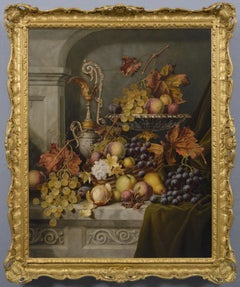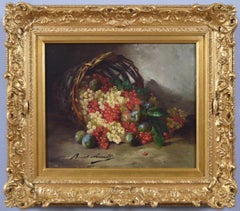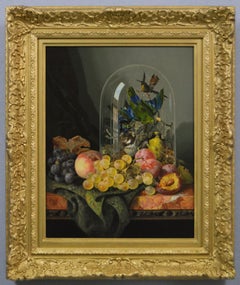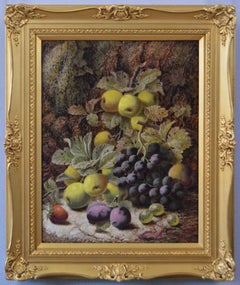Want more images or videos?
Request additional images or videos from the seller
1 of 10
Albert WilliamsSummer's BloomC.1950
C.1950
Price:$3,464.75
$4,641.22List Price
About the Item
- Creator:Albert Williams (1922 - 2010, British)
- Creation Year:C.1950
- Dimensions:Height: 24.5 in (62.23 cm)Width: 24.5 in (62.23 cm)
- Medium:
- Movement & Style:
- Period:
- Condition:
- Gallery Location:Nr Broadway, GB
- Reference Number:1stDibs: LU15622462543
About the Seller
5.0
Platinum Seller
Premium sellers with a 4.7+ rating and 24-hour response times
Established in 1972
1stDibs seller since 2015
353 sales on 1stDibs
Associations
The British Antique Dealers' AssociationLAPADA - The Association of Arts & Antiques DealersInternational Confederation of Art and Antique Dealers' Associations
Authenticity Guarantee
In the unlikely event there’s an issue with an item’s authenticity, contact us within 1 year for a full refund. DetailsMoney-Back Guarantee
If your item is not as described, is damaged in transit, or does not arrive, contact us within 7 days for a full refund. Details24-Hour Cancellation
You have a 24-hour grace period in which to reconsider your purchase, with no questions asked.Vetted Professional Sellers
Our world-class sellers must adhere to strict standards for service and quality, maintaining the integrity of our listings.Price-Match Guarantee
If you find that a seller listed the same item for a lower price elsewhere, we’ll match it.Trusted Global Delivery
Our best-in-class carrier network provides specialized shipping options worldwide, including custom delivery.You May Also Like
Roses and Chrysanthemums in a Vase
Located in Bryn Mawr, PA
An expatriate painter, noted for figurative paintings of peasants as well as classical works, Biblical scenes, mythological subjects, and still lifes, William Babcock was born in Bos...
Category
1870s Victorian Still-life Paintings
Materials
Canvas, Oil
'A Still Life of Roses, grapes and an Ivory Vase' Edward Ladell antique painting
By Edward Ladell
Located in St. Albans, GB
Edward LADELL
Picture Size: 20 x 16" (50 x 40cm)
Outside Frame Size: 26 x 22" (65 x 55cm)
An exquisite example of Ladell's painting. Signed with his traditional stylistic monogram,...
Category
1850s Victorian Paintings
Materials
Oil
$12,558 Sale Price
20% Off
Free Shipping
H 26 in W 22 in D 2 in
A Still Life of Flowers
By Henry Livens
Located in St. Albans, GB
Henry John Livens
An antique painting.
Framed oil on canvas.
Signed by the artist
Canvas Size: 20 x 24" (51 x 61cm)
Framed Size: 27 x 31" (37 x 77cm)
This stunning British Victorian...
Category
1890s Victorian Still-life Paintings
Materials
Oil
Still life of fruit on a woodland bank
Located in Stoke, Hampshire
G Gray (Early 19th Century)
Still Life of Fruit
Oil on panel
Signed
Painting Size 17.5" x 20" (44.4 x 50.8cm)
Framed Size 23 x 26 in
Category
Early 19th Century Victorian Still-life Paintings
Materials
Oil
19th century English still life of fruit on a mossy bank landscape
By Vincent Clare
Located in Woodbury, CT
Vincent Clare (British, 1855–1930)
Still Life of Fruit on a Mossy Bank
Oil on canvas, signed lower right
Circa 1870
Presented in a richly carved and gilded 19th-century style frame
...
Category
1850s Victorian Still-life Paintings
Materials
Canvas, Oil
$2,430
Free Shipping
H 10 in W 12 in
Antique French 19th century Still life of flowers in a basket
Located in Woodbury, CT
Lucienne Lemercier was a French painter from the latter part of the 19th century through the early 20th century.
She came from a family of creative people and took to painting at a...
Category
1880s Victorian Still-life Paintings
Materials
Canvas, Oil
$2,065 Sale Price
30% Off
Free Shipping
H 20 in W 27 in
Victorian antique English still life of flowers, birds nest, eggs in a garden
By Henry John Livens
Located in Woodbury, CT
Henry John Livens was born in 1858, in St Pancras, London the direct descendant of Jan Liebens who had left his native Holland in the 1600’s to paint a portrait of the King and subse...
Category
1890s Victorian Still-life Paintings
Materials
Canvas, Oil
$4,837 Sale Price
25% Off
Free Shipping
H 25 in W 29 in
19th century English oil of still life of fruit, German Stein with silver lid
By CHARLES THOMAS BALE
Located in Woodbury, CT
Outstanding English 19th century still life of fruit, a German Stein with silver top in an interior.
Charles Thomas Bale was born in Soho, London in 1849, the son of Thomas Bale, a basket maker. His older brother Thomas Charles Bale (1831-1899) was an artist and picture restorer. He lived with his family in St James, Westminster and although little is known about his education, he would have undoubtedly received encouragement and drawing tuition from his brother. Bale started exhibiting in 1866 at the Institute of British Artists, Suffolk Street. He also exhibited at the Royal Academy in 1872, the same year he married Caroline Leathem. Together, they spent their married life in St Pancras. He specialized in still life paintings predominantly of fruit, but he frequently incorporated baskets, a homage to his family’s profession, as well as pottery, glass, and game. Bale’s work was influenced by the English still-life artists George Lance and William Duffield...
Category
1890s Victorian Still-life Paintings
Materials
Canvas, Oil
$3,217 Sale Price
35% Off
Free Shipping
H 32 in W 28 in
Still Life of Flowers in a Marble Vase
By Harold Clayton
Located in Wiscasett, ME
Harold Clayton British, (1896 - 1979)
Still Life of Flowers, Oil on canvas, signed
Measuring 24" x 26" including the frame.
Provenance: MacConnal-Mason, London, UK (label reve...
Category
Mid-20th Century Victorian Still-life Paintings
Materials
Oil
Still Life of Flowers and a Blue and White Vase
Located in Wiscasett, ME
Oil on canvas, signed in the lower right and presented in a wonderful gilt frame. This vibrant still life measures 33.5" x 41.5" including the frame.
1855-1936, French
Desire Alfred Magne...
Category
Early 20th Century Victorian Still-life Paintings
Materials
Oil
$5,800
H 41.5 in W 335 in D 2 in
More From This Seller
View All19th Century still life oil painting of autumn fruit & leaves
By Henry George Todd
Located in Nr Broadway, Worcestershire
Henry George Todd
British, (1847-1898)
Autumn’s Bounty
Oil on canvas, signed & dated 1897
Image size: 31.25 inches x 25.5 inches
Size including frame: 37.75 inches x 32 inches
Provenance: Mandell’s Gallery, Norwich
A wonderful autumnal still life painting of fruit by Henry George Todd. Grapes, peaches and plums can be seen arranged in a silver dessert dish and wicker basket perched on a marble ledge. Other fruit are shown resting on the edge of the carved stone table and also draped across a green velvet hanging. Rising up next to the fruit arrangement and framed within an alcove is an ornate silver gilt ewer...
Category
19th Century Victorian Still-life Paintings
Materials
Canvas, Oil
19th Century still life oil painting of fruit
By Alfred Arthur Brunel De Neuville
Located in Nr Broadway, Worcestershire
Alfred Arthur Brunel de Neuville
French, (1852-1941)
Still Life of Fruit in a Basket
Oil on canvas, signed
Image size: 14.5 inches x 17.5 inches
Size including frame: 23.25 inches x ...
Category
19th Century Victorian Still-life Paintings
Materials
Canvas, Oil
19th Century still life oil painting of fruit & birds
Located in Nr Broadway, Worcestershire
Ellen Ladell
British, (1853-1912)
Still Life of Fruit & Exotic Birds
Oil on canvas laid on board, signed
Image size: 17.5 inches x 13.5 inches
Size including frame: 24.75 inches x 20.75 inches
Provenance: Sotheby’s The British Sale, 2003, lot 256
A beautifully painted still life of fruit with a glass dome and taxidermy birds by Ellen Ladell. Grapes, plums and a peach are shown grouped on a floral patterned green cloth at the front of a marble topped table. Behind the fruit is a large glass display dome with an arrangement of exotic taxidermy birds. The reflection in the glass gives the viewer a glimpse of a tall window with a house beyond, adding another dimension to the painting.
Ellen Ladell was born Ellen Maria Levett in Ipswich in 1853 to George and Maria Levett. Her father was a foundry smith and the family lived at 30 Borough Road in Ipswich. She initially worked as a Milliner around 1871 but sought artistic training during her spare time. It is at this point she met and became a pupil of the still life painter Edward Ladell (1821-1886), who at that time was a widower.
Ellen married Edward in Great Yarmouth on 21 October, 1878. The couple initially moved to Torquay where they had their son Kenwyn in 1880, but then decided to settle in Exeter, living at 99 Sidwell Street and setting up a studio at 20 Queen Street. Edward’s influence can been seen in her work as their styles and subject matter share some similarities. However, a number of Ellen’s paintings also included taxidermy under glass...
Category
19th Century Victorian Still-life Paintings
Materials
Canvas, Oil, Board
19th Century still life oil painting of apples, grapes & other fruit
By Oliver Clare
Located in Nr Broadway, Worcestershire
Oliver Clare
British, (1853-1927)
Still Life of Apples, Grapes & Other Fruit
Oil on canvas, signed
Image size: 17.5 inches x 13.5 inches
Size including frame: 23.5 inches x 19.5 inches
A lovely still life painting of fruit by Oliver Clare. Apples, black grapes and plums can be seen together with a strawberry and gooseberries. The fruit is shown lying amongst foliage and trailing ivy on a woodland bank.
Oliver Clare was born in Birmingham in 1853, the son of the flower artist George Clare (1839-1890) and his wife Elizabeth Bowen. His brother Vincent Clare (1856-1917) also became an artist and both would have received tuition from their father who influenced their style and subject matter. At the age of 18 he enlisted as a soldier in the Kings Own regiment, but gave this up to become a full time artist. Like his father, Clare specialised in still life paintings, containing fruit and garden flowers, often on mossy banks.
Sometime after 1871, he moved to London where he married Emma Mary Webb...
Category
19th Century Victorian Still-life Paintings
Materials
Canvas, Oil
19th Century pair of still life oil paintings of fruit and flowers
By Oliver Clare
Located in Nr Broadway, Worcestershire
***PLEASE NOTE: EACH PAINTING INCLUDING THE FRAME MEASURES 13 INCHES X 16 INCHES***
Oliver Clare
British, (1853-1927)
Still Life of Fruit & Still Life of Flowers
Oil on canvas, pair, both signed & dated ‘92
Image size: 6 inches x 9 inches (each)
Size including frame: 13 inches x 16 inches (each)
An appealing pair of still life paintings by Oliver Clare. The first painting shows primroses and lilac blossom next to a red berry. In the second, damsons can be seen next to apples and a strawberry.
Oliver Clare was born in Birmingham in 1853, the son of the flower artist George Clare (1839-1890) and his wife Elizabeth Bowen. His brother Vincent Clare (1856-1917) also became an artist and both would have received tuition from their father who influenced their style and subject matter. At the age of 18 he enlisted as a soldier in the Kings Own regiment, but gave this up to become a full time artist. Like his father, Clare specialised in still life paintings, containing fruit and garden flowers, often on mossy banks.
Sometime after 1871, he moved to London where he married Emma Mary Webb...
Category
19th Century Victorian Still-life Paintings
Materials
Canvas, Oil
19th Century still life oil painting of fruit & a vase
Located in Nr Broadway, Worcestershire
William Duffield
British, (1816-1863)
Still Life of Fruit & a Vase
Oil on canvas, signed & dated 1850
Image size: 13.5 inches x 18.5 inches
Size including frame: 18.5 inches...
Category
19th Century Victorian Still-life Paintings
Materials
Canvas, Oil
Still Thinking About These?
All Recently ViewedMore Ways To Browse
Charles Knight
18x18 Vintage Frame
Albert Williams
Pop Art Tropical
Rhoda Nicholls
Samantha Green
Still Life Chinese Porcelain
Ted Goerschner
Theresa Ferber Bernstein
Vintage Apple Pitcher
1980s Paintings With Flowers
Bearded Iris Paintings
Blue Vase Orange Flowers
Brick Building Painting
Chuck Taylor
David Larned
Fruit Painting Spanish
Gasparo Lopez



